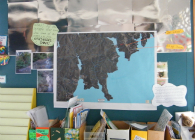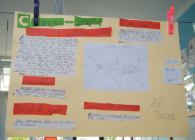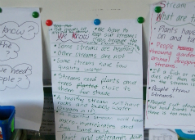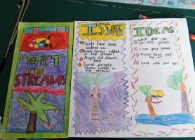Session 4
Learning Outcomes
At the end of the session students will be able to …
1. identify how humans have changed stream habitats and the water quality in an urban environment
Resources
Guardians of the Mauri (DVD)
Take Action for Water – Human Impacts (Rata and the Totara)
http://www.gw.govt.nz/assets/Get-Involved/TAFWHumanImpactssection.PDF
City Issues: Stormwater
Curriculum links
Key competencies
• Thinking
• Managing self
• Participating and contributing
Social Sciences, Science, Technology
Definition
Mauri is the life force of all living things according to the Maori world view. When the mauri is strong everything is in balance so plants and animals are healthy. But when the mauri is weak things are out of balance and plants and animals become weak and sick.
Activities
1. The Mauri of our stream
• Discuss the meaning of Mauri.
Is the mauri of our stream strong or weak? How can you tell?
Why has it become like this? Who was involved?
• Write students ideas on a chart to revisit and add to later. (eg cutting down trees, making roads and buildings, rubbish, stormwater drains …
• Watch the DVD Guardians of the Mauri.
Look at the questions above and add answers to the chart?
What have WE done? Are humans to blame for the mauri of our stream?
• Who are the kaitiaki of our stream? Who speaks for our stream? (Refer to The Lorax who spoke for the trees).
2. Where are the trees and plants?
• Read the story of Rata and the Totara (BLM 21) http://www.gw.govt.nz/assets/Get-Involved/TAFWHumanImpactssection.PDF
What would happen to the stream if Rata took the whole forest? Why did Rata take only one tree?
What lesson can we learn from Rata?
• Imagine how our stream looked before humans came to live here. What trees and plants would have grown beside our stream? Are any of the same plants there today? What new ones are there? Are any of them pests? (See below)
• List the things that trees and plants provide for the mauri of our stream: (cover … shade keeps our stream cool and stops too much algae on the rocks; roots of plants and trees hold stream banks and stop erosion … clearer, cleaner water; dead leaves provide food for aquatic animals; dead branches (logs) make homes for aquatic animals)
3. Where does our stormwater go?
• Locate the stormwater grates in your school grounds.
What goes into these grates?
Where does this water go?
Some grates might have fish painted beside them. Discuss why this is (the water flows straight into a natural waterway such as a stream, river or sea. This water is NOT treated).
• Where are stormwater drains in our community? Take a short walk along the road near your school. What might go into these grates? Discuss oil, petrol, rubber from cars; chemical spills from industry and homes, paints; green waste from gardens; concrete from construction, herbicides and pesticides, etc). What happens when we have heavy rain?
If possible show the students where the stormwater drains discharge into the stream or sea.
Could our stormwater drains have a bad effect on our local stream? How?
4. What else ends up in our stream?
• What other things have been dumped in our stream? (Students may have found household waste, tyres, supermarket trolleys …) What does this do to the mauri of our stream?
5. How have we changed our stream?
• Do you know if anyone is taking water from our stream? If so, who, why?
Do you know if anyone has straightened our stream? If so, who, how and why? Housing? Roads?
Do you know if there are culverts along our stream? If so, where, why?
What effect do these things have on the mauri of our stream?
Extension
• Visit another stream that is located in a rural area (eg Cascades in Waitakere Ranges or Karamatura near Huia)
If possible, test the water quality. Take photos of stream life and the plants and trees. Listen to the sounds.
• Which stream is healthier? How do you know? How does the area surrounding the stream affect the mauri of the stream?
Assessment
• Students complete a PMI chart to show their reactions to their new learning from this session.
| Plus | Minus | Interesting |
Additional information: URBANISATION = HABITAT LOSS
Increased population means pressure for further development which usually results in further loss of habitat, whether it is loss of bush, loss of rural land or encroachment of coastal and riparian areas. Along with increased population, development and noise; urbanisation brings more weeds and pests to compete with indigenous biodiversity.
On the positive side, there are some bird species that enjoy an advantage provided by the variety of garden plants that provide winter forage in particular.
PLANT PESTS
Plant pests are a major threat to biodiversity by changing environmental conditions through shading, smothering, or preventing other species from establishing.
Problem plant pests in Waitakere City are numerous, and include agapanthus on the west coast, Elaeagnus, woolly nightshade, wild ginger, mignonette vine, moth plant, blue morning glory, climbing asparagus, ladder fern, bamboo, honeysuckle and jasmine in the Waitakere Ranges. In the urban area pest plants also include privet, Arundo, climbing asparagus, pampas and monkey apple.
ANIMAL PESTS
Animal pests browse on palatable plant species, reducing the success rate of new plantings, degrading existing habitats and compete with native species also using these food sources.
Some also prey on native birds, invertebrates and fish. Firmly established animal pests include Norway and ship rat, mice, possums, wasps, pest freshwater fish species and mustelids, goats, pigs in the Waitakere Ranges.
In addition, there is an ongoing threat to coastal bird species, particularly New Zealand dotterel, variable oystercatcher and little blue penguin from dog predation and disturbance. Dogs and domestic cats also have easy access to valuable lowland fauna habitat, such as wetlands and tidal mudflats, because of the close proximity of residential development to these areas.
 |
 |
 |
| Session 1 Up the Creek |
Session 2 Wai … it goes round and round |
Session 3 Oh for a cool stream! |
 |
 |
 |
| Session 4 Hey! Watch where you chuck your muck! |
Session 5 Time to Come Clean |
Session 6 We’re Scheming for a Clean Stream |

